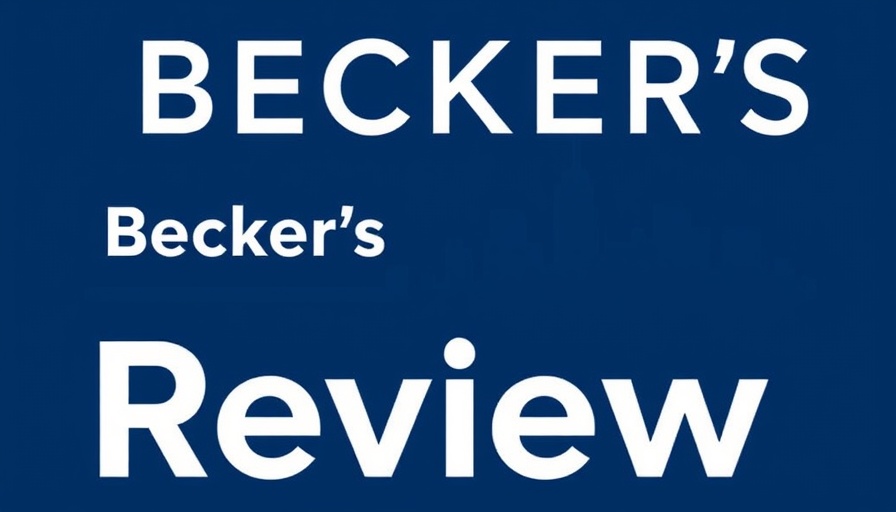
Understanding Recent Leadership Changes in Healthcare
The health sector continues to evolve, not just in terms of technology and patient care, but also at its leadership levels. The past few weeks have seen a significant number of CEO appointments and transitions across various hospitals and health systems. These shifts are vital, as the leaders of these institutions play a pivotal role in shaping the healthcare landscape and ensuring the delivery of high-quality care to communities.
Key CEO Movements and Their Implications
Recently, Cyndee McGuire, CEO of Monadnock Community Hospital, announced her retirement plans for early 2026, indicating the need for succession planning in healthcare leadership. Meanwhile, Nicole Tucker's appointment as CEO of LewisGale Hospital Alleghany illustrates how nursing professionals are stepping into significant leadership roles. This trend not only reflects a broader need for clinical expertise in executive positions but also enhances patient-centered care approaches.
Other notable changes include Brian Shelmadine stepping in as interim CEO of Box Butte General Hospital while Lori Mazanec takes a medical leave. Such scenarios often challenge hospitals to maintain continuity and morale among staff and patients during transitional phases.
The Importance of Continuity in Hospital Leadership
Continuity in leadership is crucial for maintaining the strategic direction and operational stability of hospitals. Leaders like Chris Pizzi, now COO and CFO at Asante Rogue Regional Medical Center, bring valuable experience to ensure consistent administration, especially during uncertain times. Hospitals experiencing transition must focus on integrating existing goals with fresh perspectives from new leaders to retain organizational integrity.
Rural and Independent Healthcare: A Spotlight
For independent and rural healthcare providers, leadership changes can have a ripple effect. These facilities often operate on tight budgets and are thus particularly sensitive to shifts in management. Leaders like Cam Patterson, who plans to step down due to personal reasons, spotlight the pressures faced by healthcare executives that can impact continuity and strategic planning.
Additionally, as healthcare becomes more automated, executives need to embrace technology like remote therapeutic monitoring (RTM) and healthcare automation tools to enhance patient engagement and streamline operations. This fusion of leadership and tech optimization can significantly improve practice efficiency and patient outcomes.
Future Trends in Healthcare Leadership
The healthcare sector is transitioning rapidly, with demographic shifts, technological advancements, and evolving regulations influencing the landscape. Executives will need to adapt by implementing employee health benefits that cater to an aging workforce and harnessing the power of voice AI agents for improved patient interaction.
Looking ahead, healthcare executives should prioritize strategies that not only address financial sustainability—such as optimizing Medicare reimbursement and reducing insurance underpayments—but also focus on enhancing workforce satisfaction to retain top talent in a competitive landscape. The emphasis on small practice benefits and affordable insurance plans will also be crucial for attracting future healthcare leaders.
Actionable Insights for Independent Providers
Independent practices face unique challenges, but the recent shifts highlight an essential takeaway: proactive adaptation is key. Healthcare automation and telehealth revenue growth will be critical areas to explore. By incorporating practice revenue optimization strategies and leveraging patient engagement tools, providers can enhance competitiveness and sustainability.
Furthermore, establishing pre-tax benefit plans can significantly safeguard against financial fluctuations, benefiting staff morale and retention rates. Executives should also consider implementing modern medical staff retention strategies that take into account the unique needs of both practice and patient demographics.
Conclusion: Embracing Change to Foster Growth
As the tides of leadership in healthcare continue to ebb and flow, it’s essential to recognize the opportunities embedded in these changes. Leaders who can bridge the gap between innovative health practices and compassionate patient care will undoubtedly chart a promising course for the future. For healthcare professionals and independent providers, staying informed about these transitions can empower better decision-making and pave the way for a more resilient healthcare system. Your active participation in embracing these changes, whether through innovative tech solutions or strategic HR improvements, is vital for thriving in this dynamic environment.
 Add Row
Add Row  Add
Add 




Write A Comment